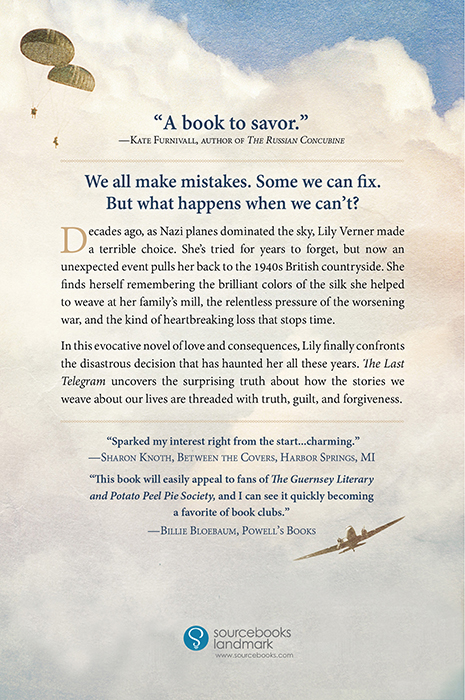Last Telegram (32 page)
Authors: Liz Trenow
Tags: #Historical, #General Fiction, #Twentieth Century, #1940's-1950's

1.
What was your
inspiration for writing
The Last Telegram
?
I was brought up in the world of silk with my father, brother, and now my nephew successively managing the company, which is still weaving today after three hundred years in the same family. I spent my early years in the house next to the mill, and as a teenager spent school holidays working there. Perhaps because of this familiarity, I didn't at first think of it as a potential setting for a novel until a friend pointed out what a uniquely interesting place it was.
As my parents grew older, I decided to interview them while their memories were still strong, and I found out that while many other mills closed, the company survived the Second World War by making parachute silk. The critical “finishing” process was actually outsourced to specialists, and they encountered initial problems in achieving the correct porosity. The London office of the firm was bombed in 1939 with the loss of all their archives, records, and accounts, though mercifully no one was killed.
My father also told me how, before the war, the family had sponsored five Jewish Kindertransport boys who were later interned. One of them returned to fight with the Allied forces and came back to marry his sweetheart, ending up as a senior manager in the company and lifelong friend of the family. There was a problem with silk supplies in the early part of the war, and I was fortunate enough to interview the son of the yarn merchant who was actually sent to the Middle East to find new sources. My uncle John spent five years in a German prisoner of war camp, and I talked to him about his experiences and learned much from his letters, which had been carefully saved by my grandparents.
So although Lily and her problems with the silk are entirely fictional, as are all my characters and what happens to them, my inspiration was certainly rooted in real people and real events.
2.
To start with, Lily seems to have little ambition or interest in silk but ends up managing a factory. How realistic is that for a woman in the first half of the twentieth century?
Life in Britain during both wars was very tough but tremendously liberating for women, providing the opportunity to learn new skills and work in areas where they never would have been accepted before. After the 1914â1918 war, many of them, sometimes reluctantly, relinquished their jobs to returning soldiers. But after 1945, women had discovered how liberating and satisfying work outside the home could be, and it became more widely accepted that they too could have careers, even if they didn't get equal pay with men. I wanted Lily's story to reflect that growing confidence and acceptance of women in the world of work.
3.
If Britain was happy to accept young Jewish refugees before
the war, how come they were deported as “enemy aliens” once the war started?
Before the war, Britain was a place of refuge for many fleeing persecution, but in 1940, after the Nazis had stormed into France and were clearly preparing to invade Britain, there was growing fear at both official and local levels about spies and infiltrators. Internment was a perhaps understandable reaction to that fear, and was eventually extended to all men and boys holding passports from enemy countries aged sixteen and over, regardless of their profession or the length of time they had lived in the UK (women were apparently not seen as such a threat!). Their subsequent treatment was in some cases scandalousâas with the 2,500 sent to Australia on the
Dunera
.
4.
Why did you decide to introduce
a gay character in Gwen? And were you tempted to let Lily and Gwen have a full-fledged affair?
I'm not sure where Gwen came from, or why she turned out to be gay! She just arrived, freckles and all, and I knew she was going to be an interesting and important character. My great-aunt Phoebe was a fiercely independent career woman who lived with a female “companion” and no one in the family ever thought this was unusual, so perhaps she was a model for Gwen. I thought about having her seduce Lily, but decided in the end that it would have been out of character for her to be predatory or for Lily to succumb, however vulnerable she was at the time.
5.
The novel includes some technical
details about silk weaving and parachutes. How much research did you have to do?
For a while, I became quite a parachute geekâreading all kinds of technical manuals and talking to experts. The silk information was easier because of my father's experience. I was also privileged to meet some of the weavers, now in their eighties and nineties, who actually wove parachute silk during the war. We held a wonderful tea party for them at the mill and their memories were invaluable. But I'm no expert, and research can only take you so farâand I am sure that some of my technical detail will be found wanting by those who know better.
6.
How easy was
it to switch from writing newspaper journalism to writing fiction?
Surprisingly difficult! Although being a journalist means I'm not afraid of facing a blank page, writing fiction is like running a marathon instead of a sprint. With journalism, the characters and the plot are fixed, but in fiction it is all down to your imagination and you have to make sure that the characters and their responses and actions are credible and logical, while keeping them exciting and interesting. If you are lucky, there comes a time when you are so “into” the story that your characters start doing unexpected things and new characters arrive uninvited, and those moments are great fun. The disciplines of journalismâdeadlines, accuracy, and consistencyâare helpful, but writing fiction is a completely different craft with its own special enjoyment.
7.
The novel is full of sad events and yet manages
to remain hopeful. Did you know how the novel would end when you started writing it?
As a feminist and the mother of two daughters, I wanted to write a coming-of-age story in which a young woman discovers her self-confidence in the world of work and becomes accepted on equal terms with men. But the trajectory of a novel can never be that simpleâthere must be trials and tragedies along the way, and the wartime setting provides plenty of these. When I started
The
Last
Telegram
, all I really knew was that it would be set in the mill during the war, that Lily would fall in love with Stefan, and somehow would end up running the company. Very little else was certain. Until I got close to the final chapters, I wasn't entirely sure how it would end, except that she would have to make peace with herself, both in relation to Gwen and to the mistake she believes she made.

Photo by David Islip
Liz Trenow's family has been silk weavers for nearly three hundred years, and she grew up next to the mill in Sudbury, Suffolk, which is the oldest family owned silk company in Britain and one of a handful still operating today. Liz worked in the mill for a few months but decided instead to become a journalist and spent fifteen years with regional and national newspapers and on BBC radio and television news.
The Last Telegram
is her first novel. Visit her online at
www.liztrenow.com
.
